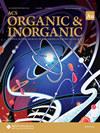Advances in Organic and Inorganic Photoredox Catalysis
IF 3.3
Q2 CHEMISTRY, MULTIDISCIPLINARY
引用次数: 0
Abstract
V light is perceived as an ideal source of energy to activate organic and inorganic compounds and mediate photophysical and photochemical transformations. In the early 20th century, Ciamician reported his vision to exploit the renewable energy potential of visible-light irradiation as a strategy for sustainable chemical development. However, the lack of color for most organic and inorganic molecules and their transparency to visible light has impeded progress toward this goal. Although the UV irradiation of organic and/or inorganic compounds has allowed the development of efficient organic and inorganic photochemical reactions, this approach suffers from poor functional group tolerance and harnesses less than 10% of the solar power potential. Over the past 20 years, a great deal of research has been devoted to triggering chemical transformations with abundant and chemically inert visible light. Inorganic materials such as TiO2 were initially reported to be potent photocatalysts, and in the 1970s, Fujishima and Honda reported an important contribution on solar watersplitting and carbon dioxide reduction, which stimulated the field of research on semiconductor photocatalysts. During the same period, the selected activation of small organic molecules by visible-light-absorbing organometallic photocatalysts was also demonstrated by several researchers, thereby establishing the foundations for visible-light homogeneous photocatalysis. However, while research on semiconductor photocatalysts progressively increased, the concept of photocatalysis in the field of organic chemistry remained undiscussed until 2008/ 2009, when MacMillan, Yoon, and Stephenson demonstrated significant advances, illustrating its significant potential for the research community. Since then, photoredox catalysis has been extensively developed in organic and inorganic chemistry, and even in other fields of science. We are pleased to launch this issue of ACS Organic & Inorganic Chemistry Au, which includes selected Reviews and Articles covering key topics and advances in organic and inorganic photoredox catalysis. Several Articles and Reviews in this issue are dedicated to the preparation of new photocatalysts. Chiral-at-metal Lewis acid catalysts, in which the chiral information comes from the metal center, have been shown to be useful in a wide range of enantioselective metal-catalyzed reactions, as discussed in the in-depth and insightful Review from Biplab Maji et al. Chiralat-metal photocatalysts have been successfully employed in several important enantioselective transformations, and their huge contribution to the recent progress of asymmetric photoredox catalysis is presented. The Review also provides a critical analysis of the topic and outlines future directions for the field. This issue contains reports on novel metal or organophotocatalysts and their applications (mainly in organic chemistry). Designing photoredox catalysts that absorb in the red-light region has recently stimulated intensive research toward broad biological applications. Katarzyna RybickaJasinśka and Dorota Gryko et al. disclose the opportunities offered by free-base porphyrin photocatalysts to functionalize biomolecules under red light irradiation. They demonstrate that free-base porphyrin can serve both as a photo-oxidant and reductant in various organic reactions. Moreover, the development of phosphorescent organometallic compounds emitting in the deep red to near-infrared has been the subject of intensive reserch in recent years. In this context, new heteroleptic bis-cyclometalated iridium complexes have been synthesized and studied by Thomas S. Teets et al. In addition, several efforts have been made to develop metal-free photocatalysts with similar redox properties to metal-based ones. In this vein, Till Opatz et al. report a two-step synthesis of polyazahelicene, which displays high reductive ability. Its efficiency as a photoreductant has been demonstrated in two multicomponent reactions and shows similar activity to Ir(ppy)3 photocatalysts. 13 The immobilization of metal-based photocatalysts is also a complementary approach to develop more eco-friendly transformations and has been the subject of intensive research in organic and inorganic chemistry. In this issue, Kelly Materna and Carl-Johan Wallentin et al. present the application of heterogeneous iridium-on-alumina as a photoredox catalyst in a set of five model reactions (reductive dehalogenation, atom-transfer radical addition, aerobic oxidative hydroxylation of boronic acids, oxidative fragmentation of ethers and acetals, and the E−Z isomerization of cinnamates). The results show that this supported photoredox catalyst displays excellent activity, higher than that of the homogeneous catalyst, with good recyclability properties. Molybdenum disulfide (MoS2) quantum dots (QDs) have attracted significant attention for application in photocatalytic water splitting for H2 generation. However, recently they have found application in photoredox transformations of organic compounds. De et al. disclose in their Article that MoS2 QDs are an efficient photocatalyst for the C−H functionalization of tetrahydroisoquinolines with indoles (or phosphites). Detailed有机和无机光氧化还原催化研究进展
本文章由计算机程序翻译,如有差异,请以英文原文为准。
求助全文
约1分钟内获得全文
求助全文
来源期刊

ACS Organic & Inorganic Au
有机化学、无机化学-
CiteScore
4.10
自引率
0.00%
发文量
0
期刊介绍:
ACS Organic & Inorganic Au is an open access journal that publishes original experimental and theoretical/computational studies on organic organometallic inorganic crystal growth and engineering and organic process chemistry. Short letters comprehensive articles reviews and perspectives are welcome on topics that include:Organic chemistry Organometallic chemistry Inorganic Chemistry and Organic Process Chemistry.
 求助内容:
求助内容: 应助结果提醒方式:
应助结果提醒方式:


